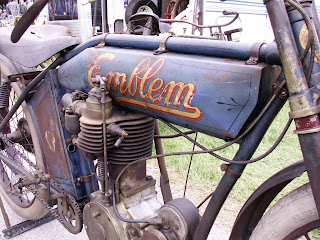This was the bike, a simple single-cylinder, 494 cc inlet over exhaust engine that produced six and half horsepower. It paved the way for much of Harley-Davidson's later success.
This bike is a 1910 Harley-Davidson 6A
Chain drive was for the starting pedals only. The bike was put on it's rear stand and started since it had no gearbox or starter. The rear wheel also houses the back-pedal type coaster brake. There was no front brake fitted.
That's a German made Bosch Magneto above the leather belt that is a free wheel clutch operated by the lever.
These machines required manual pumping 'on the fly' to keep the oil flowing.
The leather drive belts were prone to slipping and ultimately replaced by chain drive as well.
The Schebler carburetor
The Harley-Davidson logo circa 1910
Exhaust cut-out offered reduced noise in town and maximum power and sound when opened.
The view from the sprung saddle seat and wide, tiller-like bars is graceful. The hidden controls are run internally for the spark advance and the throttle.
The leading-link style forks offered a small measure of suspension for the front end at least and helped reduce broken forks on the rough roads of the day.
Capable of a maximum speed of 45 mph (72 km/h) and weighing just 195 lbs (88.5 kg), the performance was 'stately' rather than sporting.
These machines were produced from 1904 through 1918, V-Twin production began in 1907.
All photos by John P. Lawless

























































